SIR JOHN CASS
PART TWO: SIR JOHN CASS, 1661-1718
John Cass was born in Rosemary Lane in the City of London in February 1661. His father, Thomas Cass, was as a carpenter for the Royal Ordnance, which began as the Royal Gunpowder Factory in 1560 and grew into a series of factories manufacturing military materials. In 1665, London was ravaged by the bubonic plague, which was to cause the death of some 100,000 residents. In the hope of escaping the effects of the plague, Thomas Cass moved his family to Grove Street in South Hackney.
John Cass was active in the life of the City of the London as a merchant, a builder and politician. His political career began when he was elected Alderman, an old English term meaning elder man, for the ward of Portsoken, which was one of the 25 wards of the City of London and located to the east, outside the London Wall, near to Aldgate. Each ward elected an Alderman to the Court of Aldermen & Commoners who oversaw the running of the City.
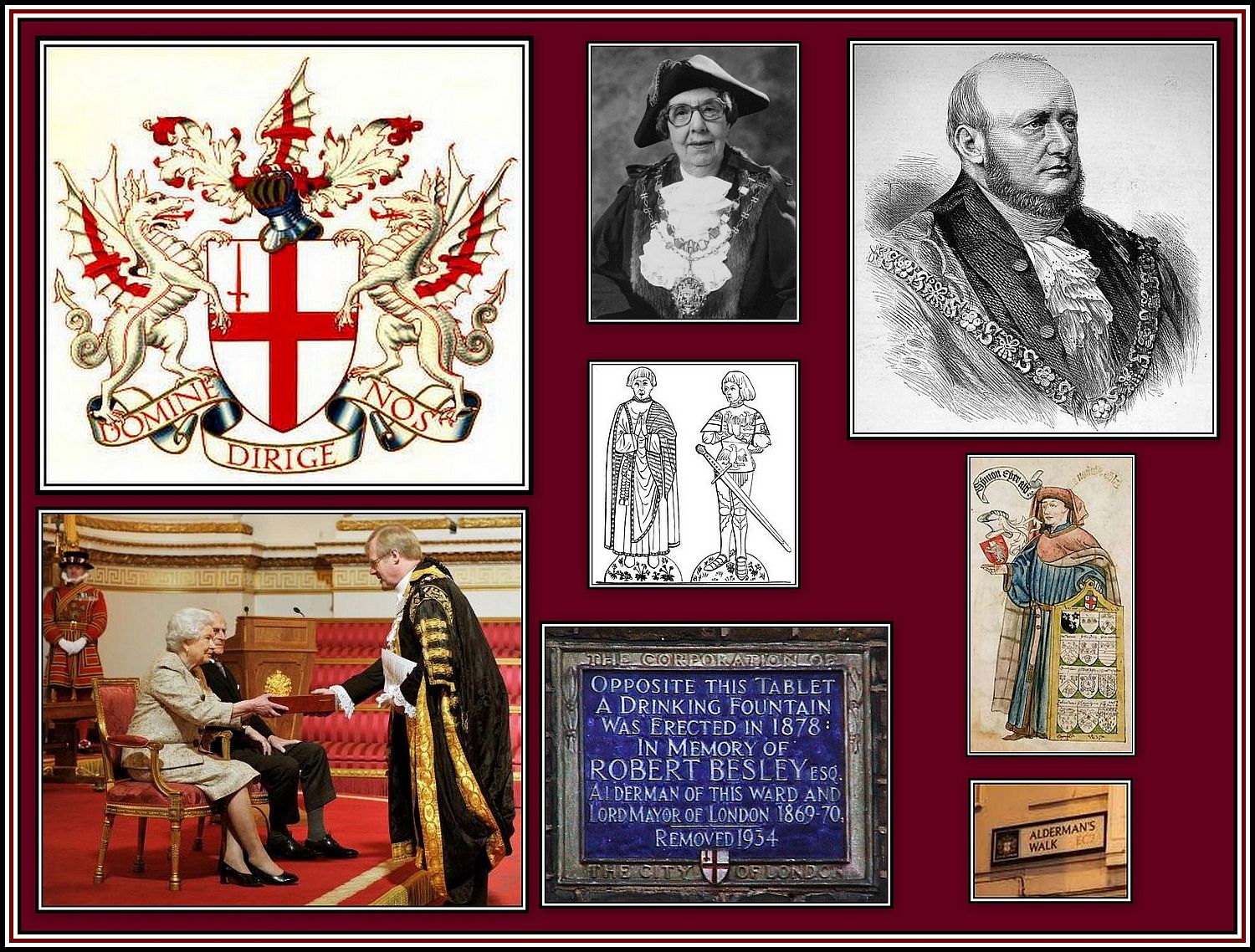
ALDERMEN (including women) OF THE CITY OF LONDON
Top Left: The coat of arms of the City of London;
Bottom Right: The Lord Mayor of the City of London with the Queen;
The Lord Mayor is required to serve as both an Alderman and a Sheriff
before being eligible for this position
In 1710, he was elected as a Tory Member of Parliament for the City of London and served until 1715. Meanwhile, in 1711, he was elected as one of the Sheriffs of the City, which brought him legal, political and ceremonial duties. In addition, he performed other duties in the City including commissioner of the newly formed Commission for Building Fifty New Churches. The commission was set-up to oversee the building of new churches to serve the expanding population of the City. In addition, between 1709 and 1715, he was treasurer of both the Bethlem Royal and Bridewell Hospitals. In 1713, he was knighted for his public service and philanthropy and became Master of the Carpenter’s Company and in 1714 he moved to the Skinner’s Company.
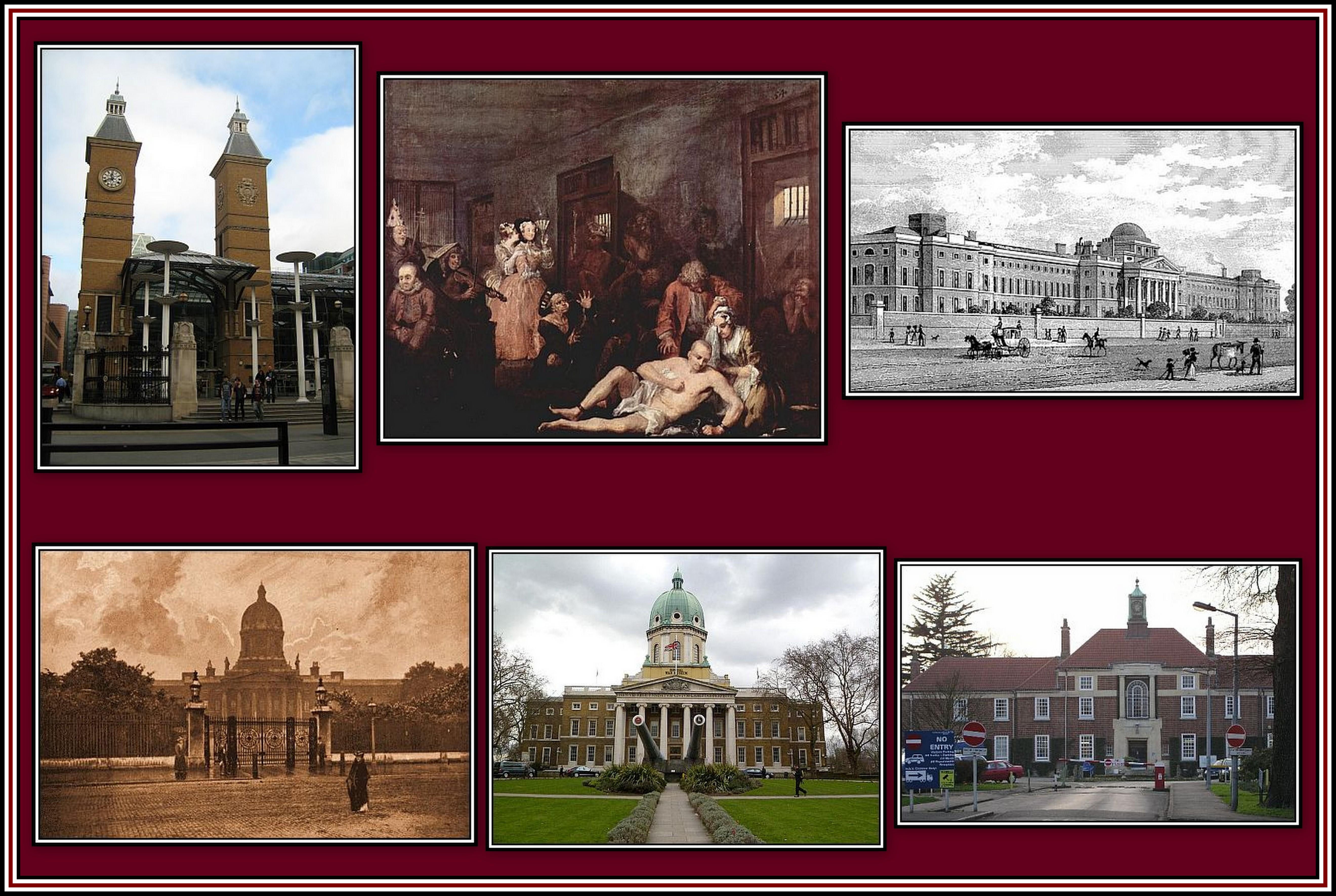 BETHLEM ROYAL HOSPITAL
BETHLEM ROYAL HOSPITAL
The original building was first mentioned in 1247, as a priory for the Sisters of the Star of Bethlehem and later, in 1357, when it became a hospital.
The original is where Liverpool Street Station now stands (Top right).
Later, it became the first hospital in the world dedicated to mental illness and became known as Bedlam.
After 1557, it became a Royal Hospital and managed by the City of London.
In 1675, the hospital moved to Moorfields just outside the City. During the 18th Century, the hospital became a place to visit and view the ill. Hogath’s painting A Rake’s Progress.
Top middle represents a daily scene at the hospital. In 1815, the hospital moved to George’s Fields, Southwark (shown in 1828, Top right) and remained here until 1930 when it was moved to the suburbs.
The old hospital (shown in 1896, Bottom left) became the home of the Imperial War Museum in 1936.
In 1999, the hospital became part of the South London & Maudsley NHS Foundation Trust (Bottom right).
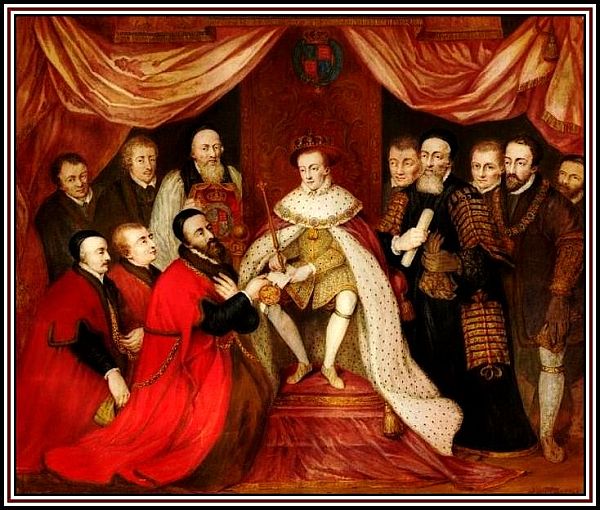 Edward VI granting a charter to Bridewell Hospital in 1553.
Edward VI granting a charter to Bridewell Hospital in 1553.
Bridewell Hospital was originally built on the of St. Bride’s Inn on the banks of the River Fleet as a palace for Henry VIII in the early 16th Century. In 1553, Edward VI gave the palace to the City of London as a haven for homeless children and disorderly women. It eventually became a school and a prison. Most of the building was destroyed during The Great Fire of London in 1666 and rebuilt the following year. In 1700, it became the first prison to hire a doctor. The prison was closed in 1855 and demolished in 1863. The school, now known as King Edward’s School, was moved to Wiley in Surrey and marked its 450th anniversary in 2003.
In 1709, Sir John Cass founded a school in buildings in the churchyard of St. Botolph’s in Aldgate, which was attended by fifty boys and forty girls. By 1718, his health began to fail. This prompted him to write a new version of his will where he hoped to secure future provision for the school by leaving all property acquired since making his first will to the school. Today, Cassland Road in Hackney commemorates land holdings once held by the Cass family in this area.
Top left: Hotel; Top middle: Terrace house front door; Top right: modern flats
Bottom left: Terrace House; Bottom middle: school; Bottom right: Terrace House, detail
While completing his new will, Sir John Cass suffered a brain haemorrhage and died with only three pages of his new will signed. This prompted his heirs to contest the latest will before the Court of Chancery and this action was to continue for some thirty years. Meanwhile, his widow continued as patroness of the school until her death in 1732. Following her demise, one of the school’s trustees named by Sir Valentine Brewis, acted as patron, but with his death in 1738, the school was closed. In 1740, the remaining trustees petitioned Parliament for a permanent endowment for the school and were successful and Sir John Cass’ will finally upheld, which eventually led to the establishment of the Sir John Cass Foundation in 1748.
Sir John Cass was buried in the churchyard of St. Mary Matfelon in Whitechapel. The original church was built in 1329 and its outside walls were covered with a bright whitewash made of lime and chalk. This caused the inhabitants of the area to refer to the church as the white chapel, which eventually gave its name to the area. This church fell into a poor state and was taken down in 1673. The third and last church on the site was built and re-consecrated in 1877, but was destroyed by fire in 1880, leaving only the tower, vestry and church rooms. The church was rebuilt and opened in 1882, but suffered severe damage during an air raid on the 29th December, 1940. I remember seeing the red brick remnants of the church on way to school and always found the colour of the brick attractive and was most disappointed when demolition began in 1952. Today, all that remains of the church are a few graves and a small external arch on Whitechapel Road. Following demolition, the churchyard and church area were turned into St. Mary’s Park, which was renamed in 1998 as the Altab Ali Park in memory of the young Bangladeshi clothing worker who was murdered close by in 1978.
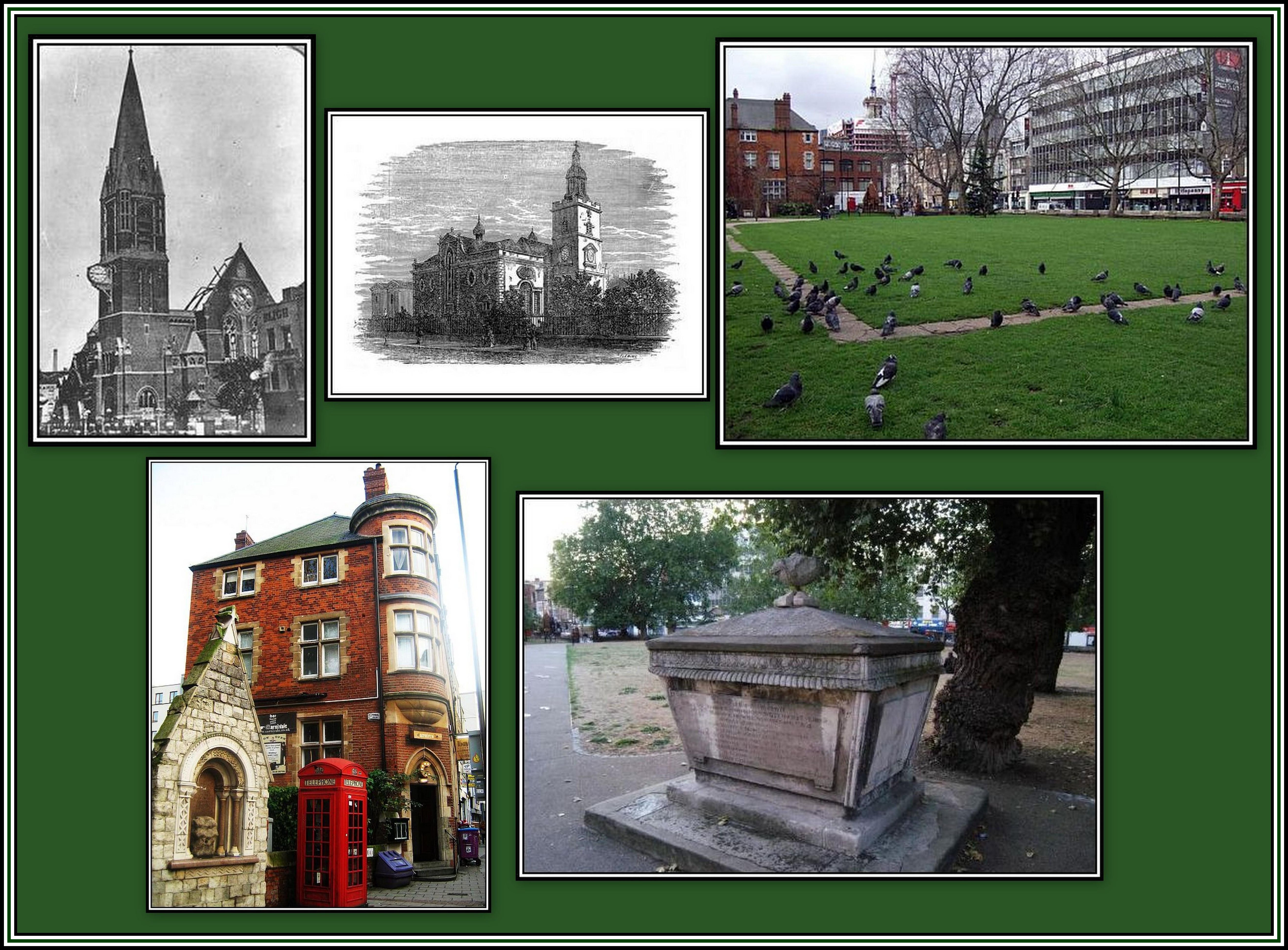 St. Mary Metfalen-Altab Ali Park
St. Mary Metfalen-Altab Ali Park
Top left: the church after being bombed in 1940; Top middle: print of an earlier church;
Top right: the churchyard, now a park today;
Bottom left: the foundation – one of the few remaining features of the church
Bottom right: a remaining grave site (picture reproduced by permission of Matt Hucke – gravesites.com).
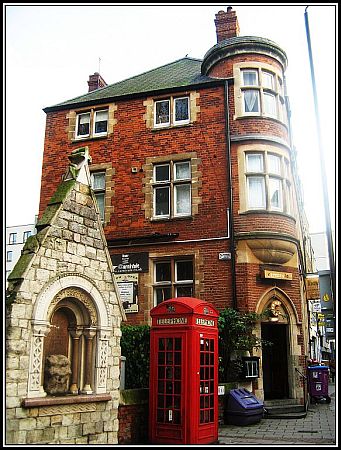 Part of what little remains of the church (2006)
Part of what little remains of the church (2006)
——oooOOOooo——
The Sir John Cass Foundation has continued to fund the Sir John Cass Foundation School in Duke’s Place, Aldgate and has provided funds for secondary and tertiary education as well for the support of work with young people across inner London. This began in 1899 with the founding of the Sir John Cass Technical Institute.
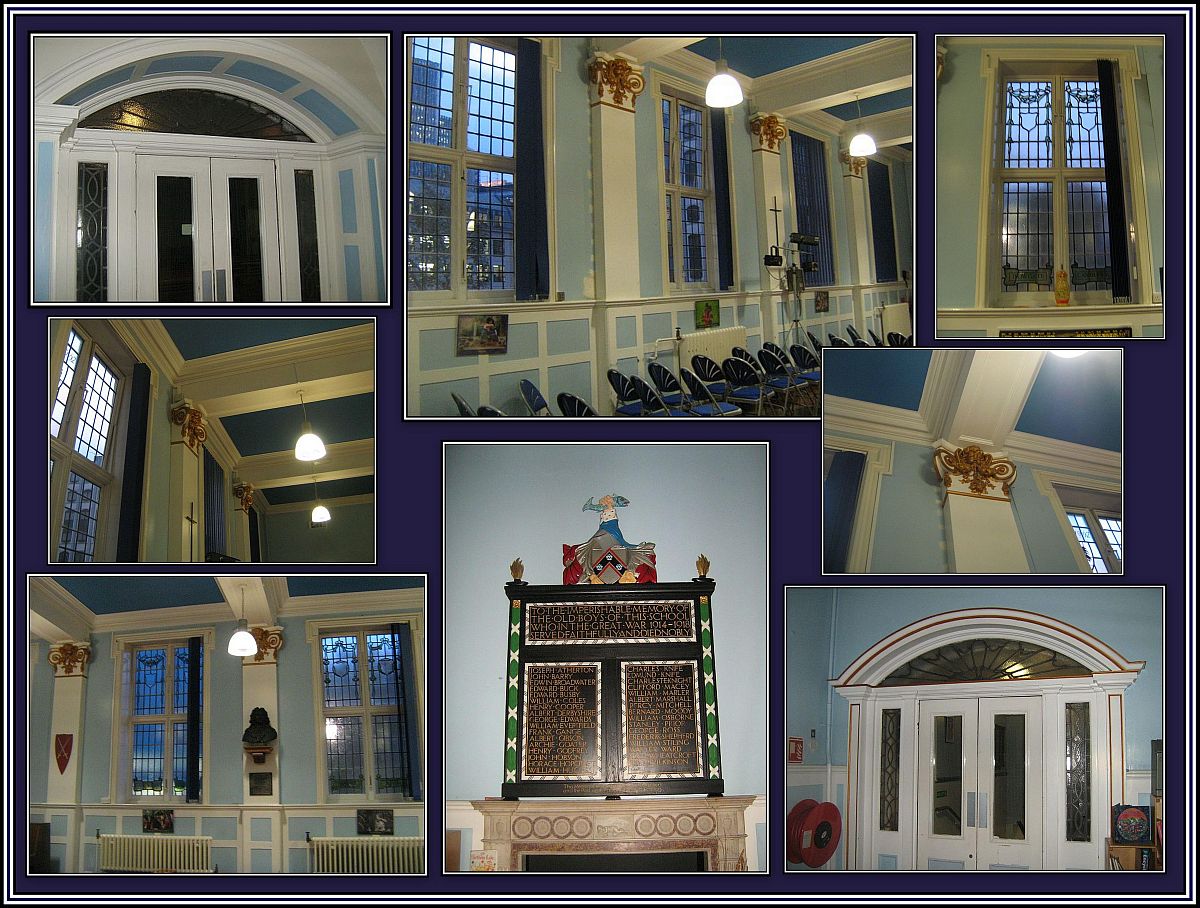 Sir John Cass Foundation School – Assembly Hall
Sir John Cass Foundation School – Assembly Hall
-oOo-
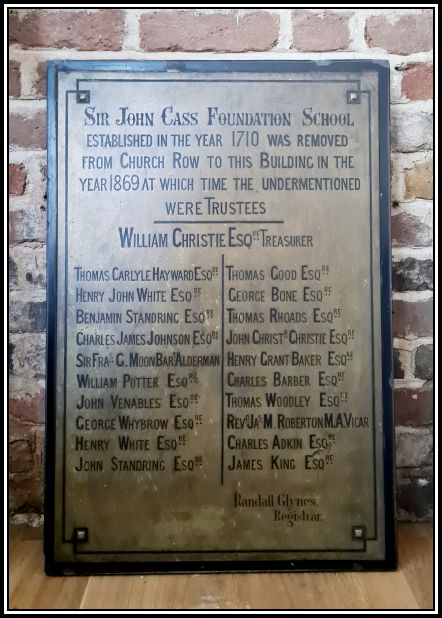
This photograph of this plaque was provided by Mr. Nick Richards
whose son discovered it in Mile End
-oOo-
In 1902, the Institute became housed in a new building across Aldgate High Street from Duke’s Place in Jewry Street. In 1950, the Institute became Sir John Cass College and in 1965, the College’s Department of Fine & Applied Art was merged with the Department of Silver Smithing & Allied Crafts of the Central School of Art. Together, these departments formed the Sir John Cass School of Art, which was relocated to Central House found opposite the Whitechapel Art Gallery.
 SIR JOHN CASS COLLEGE ON JEWRY STREET
SIR JOHN CASS COLLEGE ON JEWRY STREET
The Sir John Cass College was merged with the City of London College in 1970 to form the City of London Polytechnic. In 1992 the Polytechnic was awarded university status with the name, London Guildhall University. In 2002, the university merged with the University of North London to form the London Metropolitan University. Today the Sir John Cass Foundation provides financial support to the Sir John Cass Faculty of Art, Media & Design within London Metropolitan University and the Cass Business School within City University.
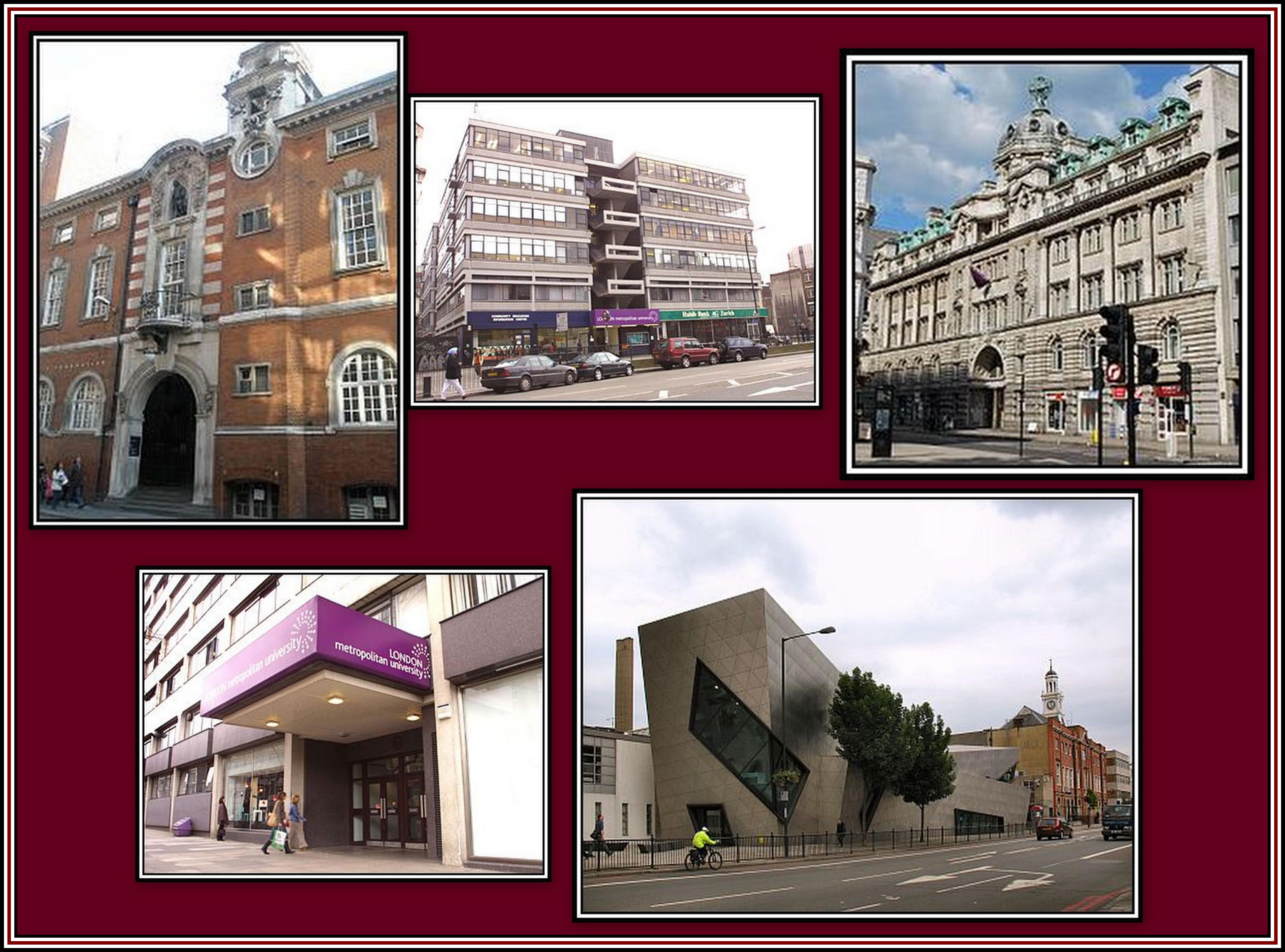 LONDON METROPOLITAN UNIVERSITY
LONDON METROPOLITAN UNIVERSITY
Top left: The original Sir John Cass College building, Jewry Street;
Top middle: Central House, Whitechapel; Top left: Electra House;
Bottom left: Commercial Road Campus; Bottom right: Post-Graduate Centre.
The Foundation has also provided funding for the Sir John Cass School of Education at the Stratford campus of the University of East London and for the Sir John Cass Hall, a student residence in Well Street, Hackney. In addition, the Sir John Cass Foundation has also provided funds for other projects including funding of a row of almshouses through land owned by Sir John Cass on Hackney Marshes and which were subsequently rebuilt in 1849 by the Foundation.
The building occupied by the Sir John Cass Foundation School in Duke’s Place was built in 1902 and served as both a primary and secondary school until 1965. In that year, through contribution by the Sir John Cass Foundation, the London County Council and the Department of Education, the Sir John Cass Foundation & Redcoat Secondary School was established in Stepney and incorporated the secondary school sector of the school in Duke’s Place. The existing school in Duke’s Place then became the Sir John Cass Foundation Primary School. The Sir John Cass Foundation continues to provide support to both schools and has representatives on the each school’s Board of each school and holds the freeholds of both school sites.
On Founder’s Day, which is celebrated in February each year, the pupils of the Sir John Cass schools wear red quills in their lapels and make their way St. Botolph’s Church in Aldgate to attend a service in remembrance of Sir John Cass. As in the time when I attended the school, each pupil receives an orange and a bun, thanks to the generosity of the founder.
I recently received this delightful photograph of an ex-pupil of the school who attended along with her sister during the 1950s on Founder’s Day. She is seen here second from the left with three classmates. Each is wearing the red feather attached to their berets. Today, the girls do not do this. They wear them attached to the lapels of their coats, just like the boys.
The year 2010 marked the tercentenary of the Sir John Cass Foundation School. On 2nd February, 2010, this special Founder’s Day was observed and celebrated with the usual service at St. Botolph’s Church and by a luncheon at the Mansion House that was attended by City dignitaries and the Duke of Gloucester.
 PUPILS OF THE 1950s .
PUPILS OF THE 1950s .
Upper Left: I am on the back row, second from the end on the right
and
Lower Right: second from the left in the middle row
——oooOOOooo——
I had intended to write a third part to this tale, but this story is too long to appear here. It is to appear along with Parts One & Two as a short book on Amazon’s Kindle in the near future.
The book will be for sale at a ROCK BOTTOM price.
——oooOOOooo——
ST. BOTOLPH’S CHURCH
St. Botolph’s-without-Aldgate is the official name of St. Botolph’s, a Church of England church, which is found at the north-east corner of Houndsditch and Aldgate High Street in the City of London. In 1709, Sir John Cass founded a school in its churchyard that was attended by fifty boys and forty girls. Once the school moved to Duke’s Place, the church continued to serve as the site of the school’s Founder’s Day Remembrance Service.
The first recording related to St. Botolph’s was made in 1108 by the Rector. Construction of a Saxon church began in 1115 and was enlarged in 1418 and rebuilt in the sixteenth century. In 1739, this church was deemed unsafe and was demolished. Construction of the current church began in 1741 and completed in 1744. It was designed by George Dance the Elder who was also responsible for the design of the Mansion House. It was constructed in brick and has stone quoins and window casings together with a squire tower topped with an obelisk spire. The architect of Westminster Cathedral, J.F. Bentley, undertook the remodeling of St. Botolph’s at the end of the nineteenth century. This included the carved ceiling and associated plasterwork, the chancel, construction of a balustrade at the front of the gallery and replacement of the seating.
In 1941, the church was hit by a bomb, which failed to explode and, in 1965, the interior was damaged by fire. Rebuilding included the formation of the Baptistery under the tower. St. Botolph’s was designated a Grade I listed building in 1950 and re-hallowed on the 8th November, 1966 by the Bishop of London. Those present included the Queen, the Queen Mother and the Lord Mayor of London.
Jack the Ripper murdered his victims close by the church in 1888. At this time, the church was often referred to as the Church of Prostitutes since it was close to where such women offered themselves to passers-by.
——oooOOOooo——
Click here to return to PART ONE: FIRST SCHOOL, FIRST DAY & BEYOND
——oooOOOooo——
Click here to go to SIR JOHN CASS PHOTO GALLERY
——oooOOOooo——
Click here to return to SIR JOHN CASS Home Page
——oooOOOooo——
Click here to return to the TABLE OF CONTENTS
——oooOOOooo——

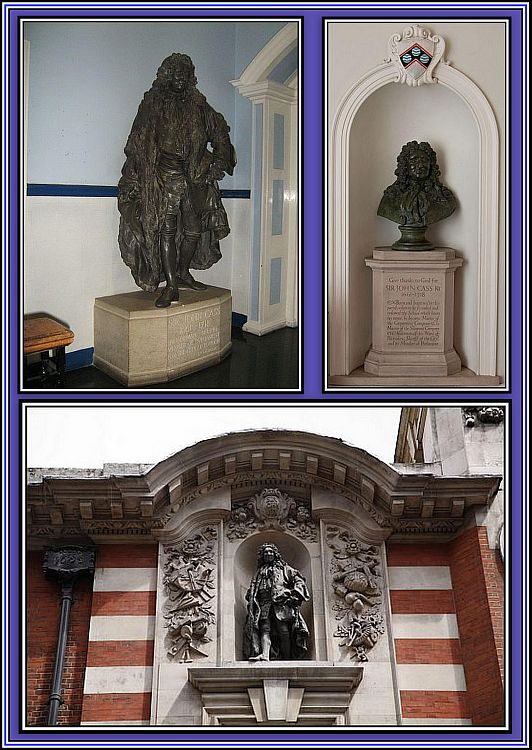
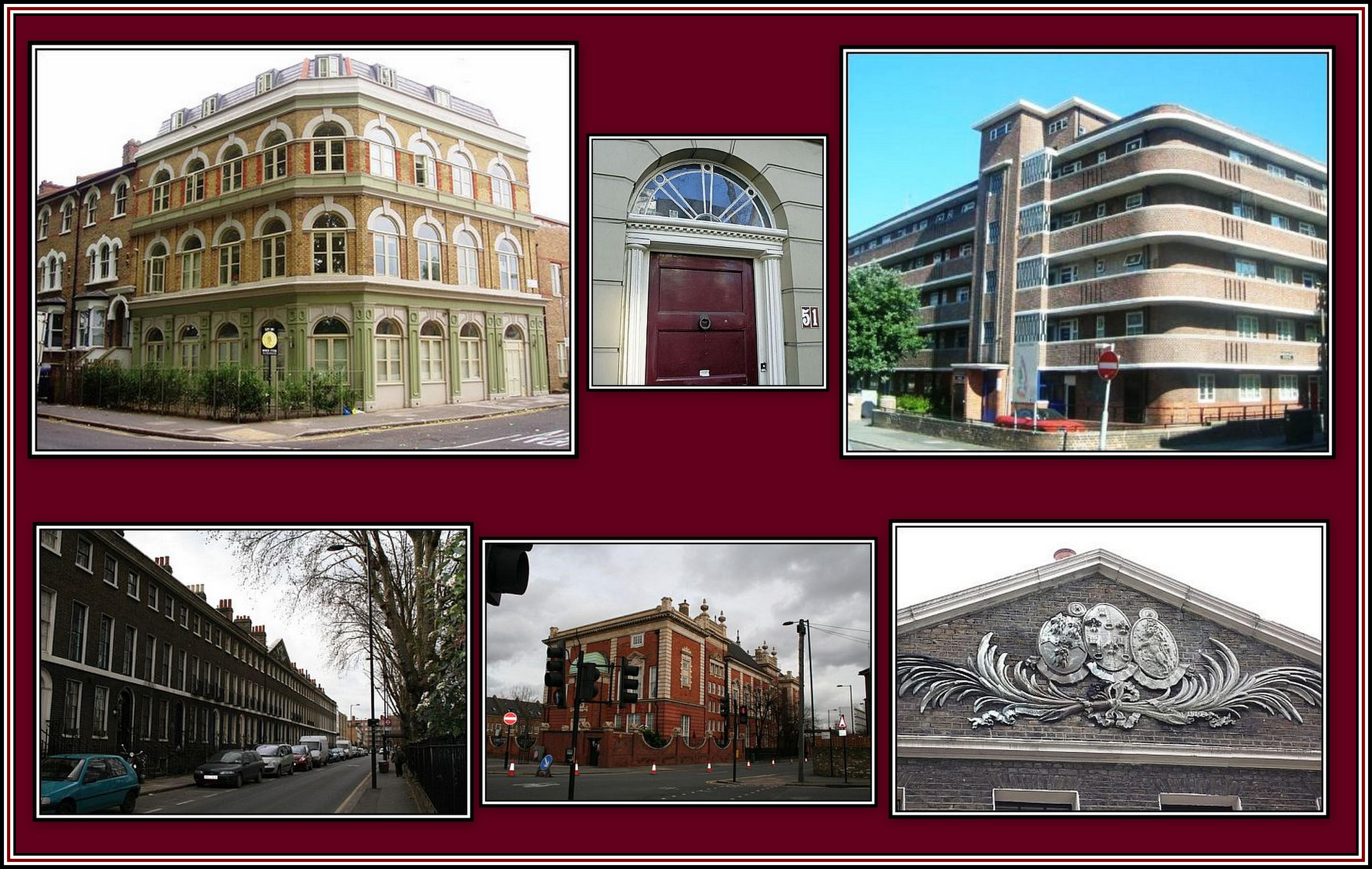
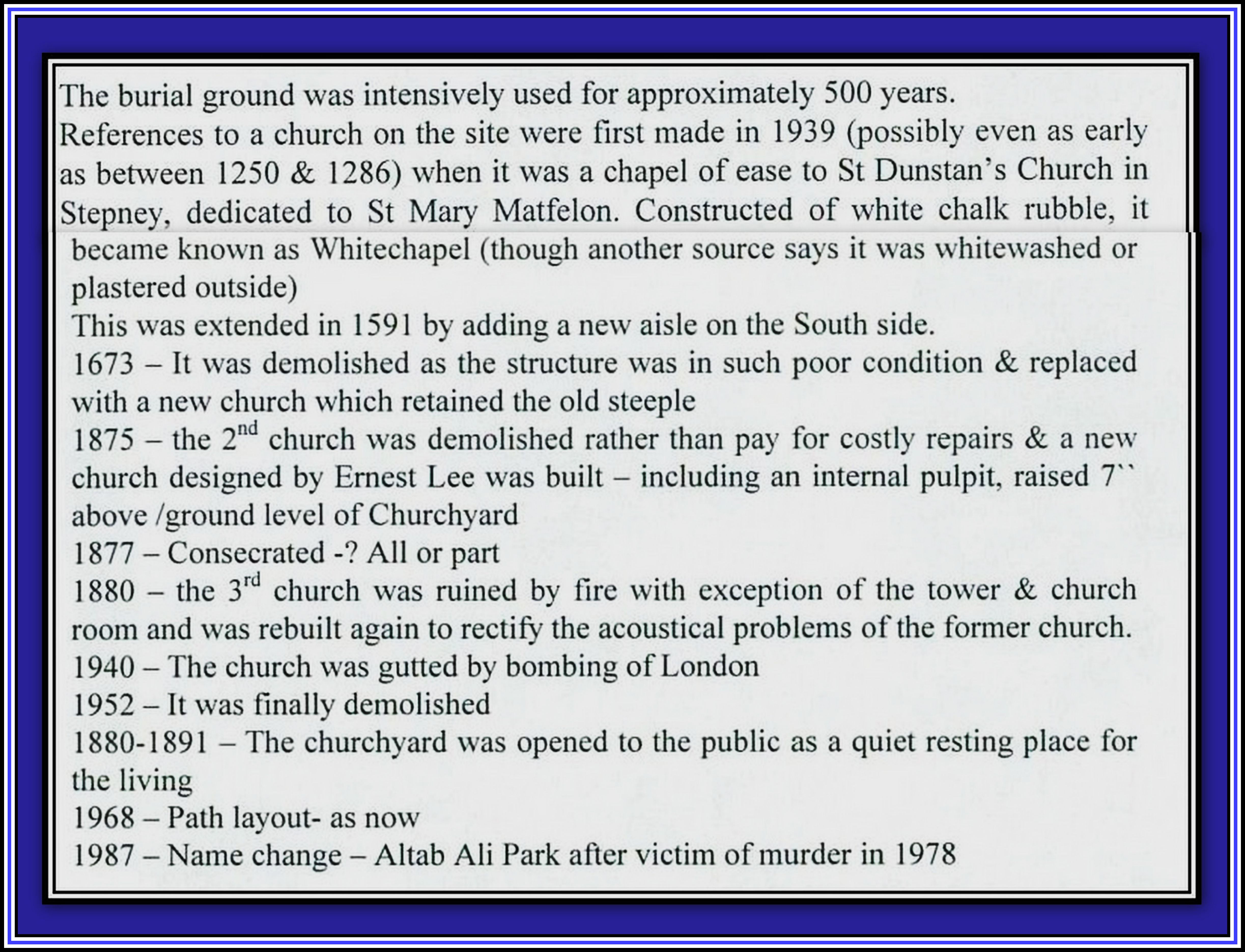
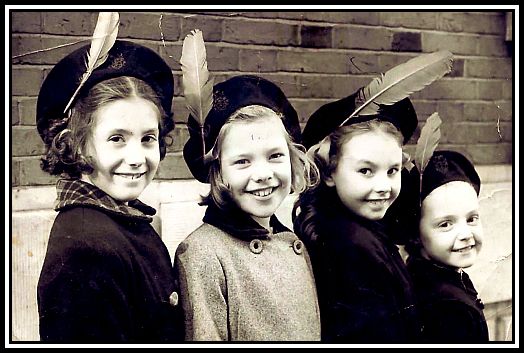
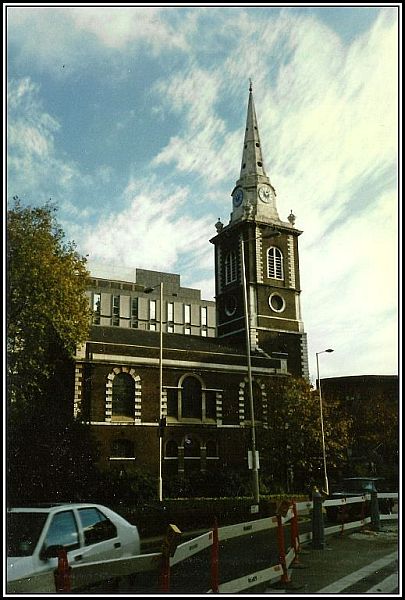
As a Four/five year old I went to Sir John Cass School (my sister who is 2 years older than me also went there) and the stories about the school especially Foundation Day bring back happy memories. I have a photograph of myself with three other pupils wearing the red feather in our berets. There was also an article in the Evening Standard which showed the photograph. I also have a class photograph which was taken on the roof of the school which I thought was the playground in those days. There were railings all around. I used to live in a prefab in Stepney and my Mum would put my sister and I on the bus and we would go to school on our own. One would’t dream of doing that these days!
Thanks for bringing back the memories of those wonderful times. Now that I am retired I have plenty of time to reminisce.
My maiden name was Cass ,name from London Family. I hope I was related to Sir John Cass has he truly was an inspiration to many people with all the things he did and all the buildings he set up. Cass Arts, The Cass Business School and other schools. An interesting read.
Hi Gillian
I am researching my wife’s family history and my own and it seems we may both be related to one Thomas Cass, possible relative of Sir John.
Our possible shared ancestor Ann Cass, had two daughters: Grace who married Stanley Philip, and Louise who married Albert.
My wife is related to Grace, and I am possibly related to Louise.
I’ve omitted family names for the spouses for obvious reasons, but if the names mean anything to you I’d be keen to be in contact because I have more information about the Cass line that might interest you, and a few questions you might be able to answer for me.
Hi I’m contacting you has I received a message from the researcher of this site about you and ive only just noticed this my maiden name was Cass and it came from my Gran fathers side who came from London I can only find Lewisham area for himself and his father my great Grandad I haven’t done any trace of this side of family .My email address is gillheffron21@googlemail.com if you would like to contact me kind regards Gillian
As a Cass pupil who went to the old Cass and the new Cass in Stepney this bought back some wonderful memories. I never tire of reading the history, fantastic pictures. I still have a red feather and remember getting an orange and bun quite vividly. And when in London often make a detour to view the school.
I attended what I remember as the Sir John Cass College to prepare for my Board of Trade examination as Master Mariner. I am fascinated by the legacy of all the many acts of Sir John Cass which you describe. Thank you.
As time passes, one experiences nostalgia for details which may or may not be of intrest to others. I passed my master”s examination and subsequently commanded several vessels of the United States Army Tansportation Corps, having been drafted into the US Army while resident in the Untited States at the time of the Korean War.
Found this site qute acidentally, I attended Cass School during 1951 to 1955 in Dukes Place and often pass it on my way to John Stow House for insurance meetings. I wonder how many old (literally) pupils look at this site and might remember me.
Good work, a great man. I’m self-studying the area of my ancestors and was wondering why the school was called “Red Coat”. I know previous to his birth the area was non-conformist/Independents and for Parliament(New Model Army) – the first Redcoats. However his Tory alliance doesn’t make sense, so what is it symbol of? Just a great colour!
When I was a postgraduate student at King’s London I was allowed to do 6 hrs teaching a week and so spent one day a week teaching English at the Stepney school. It was hard at first (when I went into my first class the children all banged down their desk lids and I jumped out of my skin! My first experience of teaching!! The games teacher ran in from outside and blew his whistle to stop the racket!). But after that I got to know the children and I loved it. They were less naive than I was and had all sorts of stories to tell. They taught me more than I taught them!! So interesting to know about Sir John Cass. He really made a difference: an inspiration for us all.
I was a pupil of the Aldgate school c 1967-69 and clearly remember Founder’s Day, the red quill feathers. the oranges and buns. I don’t recall being taught about Sir John’s involvement in the slave trade and his membership of the West Indies trading company that was the source of his wealth. It turns out the red feather was a romantic myth made up by a previous headmaster: with his last gasp dying Sir John coughed up blood all over his quill pen as he altered his will to benefit his educational foundation. Baloney! He died of a brain haemorhage. The unfinished will was a matter of contention in the courts which ruled in favour of the foundation. All the lands that Cass had acquired (from the profits made from slavery in the sugar plantations) in East London around Hackney, their rents and sales income was used to support the schools. Was Cass trying to buy a ticket to heaven by his philanthropy? Was his generosity motivated by a guilty conscience? We will probably never know, because instead of being taught the facts and the real history we were fed romantic myths to hide a murky and inglorious past. I am still grateful for the education I received there, though.
My. Auite Edith. Cass. She got John Cass. In her family. I hope to hear from you
My mother who is now 96 attended Sir John Cass School when she was 5 in 1933. I have been showing her the photographs, she remembers someone falling or throwing themselves from a high building behind the playground and the games master rushing out to cover the remains. Her name is Iris Sybil Humphries now Bell.
Thanks very much for visiting my website. How sad for your mother to have been aware of such a terrible event. Please give your mother my kind regards. Charles Jenkins